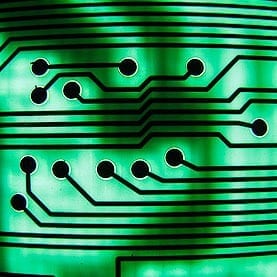Computer chips inspired by human neurons can do more with less power
Kwabena Boahen got his first computer in 1982, when he was a teenager living in Accra. “It was a really cool device,” he recalls. He just had to connect up a cassette player for storage and a television set for a monitor, and he could start writing programs.
But Boahen wasn’t so impressed when he found out how the guts of his computer worked. “I learned how the central processing unit is constantly shuffling data back and forth. And I thought to myself, ‘Man! It really has to work like crazy!’” He instinctively felt that computers needed a little more ‘Africa’ in their design, “something more distributed, more fluid and less rigid”.
Today, as a bioengineer at Stanford University in California, Boahen is among a small band of researchers trying to create this kind of computing by reverse-engineering the brain.
The brain is remarkably energy efficient and can carry out computations that challenge the world’s largest supercomputers, even though it relies on decidedly imperfect components: neurons that are a slow, variable, organic mess. Comprehending language, conducting abstract reasoning, controlling movement — the brain does all this and more in a package that is smaller than a shoebox, consumes less power than a household light bulb, and contains nothing remotely like a central processor.
To achieve similar feats in silicon, researchers are building systems of non-digital chips that function as much as possible like networks of real neurons. Just a few years ago, Boahen completed a device called Neurogrid that emulates a million neurons — about as many as there are in a honeybee’s brain. And now, after a quarter-century of development, applications for ‘neuromorphic technology’ are finally in sight. The technique holds promise for anything that needs to be small and run on low power, from smartphones and robots to artificial eyes and ears. That prospect has attracted many investigators to the field during the past five years, along with hundreds of millions of dollars in research funding from agencies in both the United States and Europe.
Neuromorphic devices are also providing neuroscientists with a powerful research tool, says Giacomo Indiveri at the Institute of Neuroinformatics (INI) in Zurich, Switzerland. By seeing which models of neural function do or do not work as expected in real physical systems, he says, “you get insight into why the brain is built the way it is”.
And, says Boahen, the neuromorphic approach should help to circumvent a looming limitation to Moore’s law — the longstanding trend of computer-chip manufacturers managing to double the number of transistors they can fit into a given space every two years or so. This relentless shrinkage will soon lead to the creation of silicon circuits so small and tightly packed that they no longer generate clean signals: electrons will leak through the components, making them as messy as neurons. Some researchers are aiming to solve this problem with software fixes, for example by using statistical error-correction techniques similar to those that help the Internet to run smoothly. But ultimately, argues Boahen, the most effective solution is the same one the brain arrived at millions of years ago.
“My goal is a new computing paradigm,” Boahen says, “something that will compute even when the components are too small to be reliable.”
Silicon cells
The neuromorphic idea goes back to the 1980s and Carver Mead: a world-renowned pioneer in microchip design at the California Institute of Technology in Pasadena. He coined the term and was one of the first to emphasize the brain’s huge energy-efficiency advantage. “That’s been the fascination for me,” he says, “how in the heck can the brain do what it does?”
Mead’s strategy for answering that question was to mimic the brain’s low-power processing with ‘sub-threshold’ silicon: circuitry that operates at voltages too small to flip a standard computer bit from a 0 to a 1. At those voltages, there is still a tiny, irregular trickle of electrons running through the transistors — a spontaneous ebb and flow of current that is remarkably similar in size and variability to that carried by ions flowing through a channel in a neuron. With the addition of microscopic capacitors, resistors and other components to control these currents, Mead reasoned, it should be possible to make tiny circuits that exhibit the same electrical behavior as real neurons. They could be linked up in decentralized networks that function much like real neural circuits in the brain, with communication lines running between components rather than through a central processor.
By the 1990s, Mead and his colleagues had shown it was possible to build a realistic silicon neuron (see ‘Biological inspiration’). That device could accept outside electrical input through junctions that performed the role of synapses, the tiny structures through which nerve impulses jump from one neuron to the next. It allowed the incoming signals to build up voltage in the circuit’s interior, much as they do in real neurons. And if the accumulating voltage passed a certain threshold, the silicon neuron ‘fired’, producing a series of voltage spikes that traveled along a wire playing the part of an axon, the neuron’s communication cable. Although the spikes were ‘digital’ in the sense that they were either on or off, the body of the silicon neuron operated — like real neurons — in a non-digital way, meaning that the voltages and currents weren’t restricted to a few discrete values as they are in conventional chips.
That behavior mimics one key to the brain’s low-power usage: just like their biological counterparts, the silicon neurons simply integrated inputs, using very little energy, until they fired. By contrast, a conventional computer needs a constant flow of energy to run an internal clock, whether or not the chips are computing anything.
Mead’s group also demonstrated decentralized neural circuits — most notably in a silicon version of the eye’s retina. That device captured light using a 50-by-50 grid of detectors. When their activity was displayed on a computer screen, these silicon cells showed much the same response as their real counterparts to light, shadow and motion. Like the brain, this device saves energy by sending only the data that matters: most of the cells in the retina don’t fire until the light level changes. This has the effect of highlighting the edges of moving objects, while minimizing the amount of data that has to be transmitted and processed.
Coding challenge
In those early days, researchers had their hands full mastering single-chip devices such as the silicon retina, says Boahen, who joined Mead’s lab in 1990. But by the end of the 1990s, he says, “we wanted to build a brain, and for that we needed large-scale communication”. That was a huge challenge: the standard coding algorithms for chip-to-chip communication had been devised for precisely coordinated digital signals, and wouldn’t work for the more-random spikes created by neuromorphic systems. Only in the 2000s did Boahen and others devise circuitry and algorithms that would work in this messier system, opening the way for a flurry of development in large-scale neuromorphic systems.
Among the first applications were large-scale emulators to give neuroscientists an easy way to test models of brain function. In September 2006, for example, Boahen launched the Neurogrid project: an effort to emulate a million neurons. That is only a tiny chunk of the 86 billion neurons in the human brain, but enough to model several of the densely interconnected columns of neurons thought to form the computational units of the human cortex. Neuroscientists can program Neurogrid to emulate almost any model of the cortex, says Boahen. They can then watch their model run at the same speed as the brain — hundreds to thousands of times faster than a conventional digital simulation. Graduate students and researchers have used it to test theoretical models of neural function for processes such as working memory, decision-making and visual attention.
“In terms of real efficiency, in terms of fidelity to the brain’s neuronal networks, Kwabena’s Neurogrid is well in advance of other large-scale neuromorphic systems,” says Rodney Douglas, co-founder of the INI and co-developer of the silicon neuron.
Go deeper with Bing News on:
Neuroelectronics
- Feed has no items.
Go deeper with Google Headlines on:
Neuroelectronics
[google_news title=”” keyword=”Neuroelectronics” num_posts=”5″ blurb_length=”0″ show_thumb=”left”]
Go deeper with Bing News on:
Neuromorphic engineering
- Scientists Built a Working Human Brain Cell Out of Salt and Water
Scientists have long mimicked human synapses using conventional solid materials, but new research attempts to recreate using extremely basic ingredients: water and salt. By recreating human synapses ...
- Scientists use salt, water to prove human brain-like computer can exist
The artificial synapse known as an iontronic memristor functions as a microchannel filled with a solution of water and salt.
- Researchers develop low-power artificial neurons mimicking locust brains for obstacle detection
In a study researchers have developed ultra-low power artificial neurons capable of obstacle detection by mimicking locust brains ...
- New 2D material manipulates light with remarkable precision and minimal loss
Responding to the increasing demand for efficient, tunable optical materials capable of precise light modulation to create greater bandwidth in communication networks and advanced optical systems, a ...
- World’s largest neuromorphic computer by Intel works like human brain
Intel says its new brain-like computer is significantly fast, energy-efficient and it has the potential to revolutionize future AI tools.
Go deeper with Google Headlines on:
Neuromorphic engineering
[google_news title=”” keyword=”Neuromorphic engineering” num_posts=”5″ blurb_length=”0″ show_thumb=”left”]










